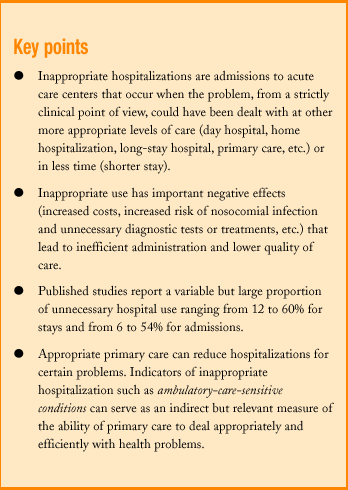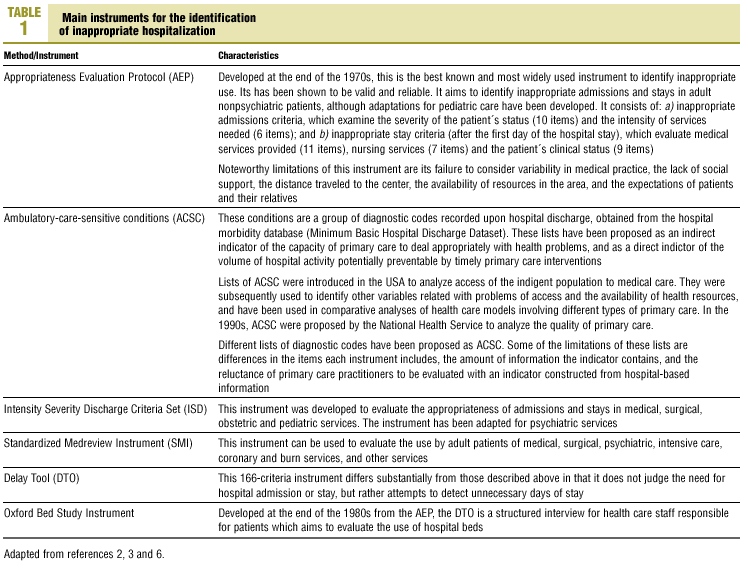In recent years, studies that examine reforms in the use of health care resources have proliferated in Spain their aim being to identify and reduce the inappropriate use of health care services. Inappropriate or inadequate use is understood to mean types of use that, with the knowledge and means currently available, do not meet ideally desirable goals. Although there are many aspects of inappropriate use that are amenable to analysis (for example, prescribing practices or complementary tests, among others), most research has centered on the inappropriate use of hospital resources.1-4
Efforts to identify when hospital admission is and is not appropriate aim to favor the most efficient use of hospitals by identifying and reducing inappropriate admissions and stays. These are defined as acute care admissions and stays that occur when the problem, from a strictly clinical point of view, could have been dealt with at other more appropriate levels of care (day hospital, home hospitalization, long-stay hospital, primary care, etc.) or in less time (shorter stay). This definition assumes that the care provided is always pertinent in clinical terms; the only things that are being questioned are the level of service that provides the care, and the duration of care.3,5
Inappropriate use has important negative effects (increased costs, increased risk of nosocomial infection and unnecessary diagnostic tests or treatments, etc.) that lead to inefficient administration and lowered quality of care.3,4 The first studies of inappropriate hospitalization were done in the 1970s. Several objective methods based on explicit criteria are currently available to identify inappropriate admissions (Table 1). These methods are usually developed by reviewing the medical records (retrospectively in most cases), the patient´s clinical status, and the intensity of medical and nursing services required.2,3,5,6 The main advantage of efforts to ensure efficiency based on determinations of appropriate use is their selectivity for unnecessary hospitalization, in contrast with other types of intervention (such as productivity and performance audits, special programs, and co-payment) that might reduce both inappropriate and appropriate care indiscriminately.3
Despite considerable differences in methods, published studies have documented a variable but large proportion of unnecessary hospital use, ranging from 12 to 60% for stays and from 6 to 54% for admissions. Moreover, the proportion of inappropriate pediatric admissions is reportedly one out of every four or five hospitalizations.1,3,6
Inappropriate hospitalization is a multicausal phenomenon that depends on decisions made by the physician; these decisions in turn are related to (among other things) the availability of diagnostic and therapeutic resources, the characteristics of primary care, and the sociosanitary resources in the area.1 However, delays in diagnostic tests comprise one of the main reasons for inappropriate admissions.
Among the measures proposed to reduce inappropriate use are the development of clinical guidelines, increases in the effectiveness of central hospital services, greater availability of alternatives to acute care hospitals (such as short-stay high-performance units, home hospitalization and day hospitals), and fomenting self-care. Although given insufficient attention in most studies, a key element in reducing the problem is the timely involvement of primary care services.5
On occasions there is no scientific evidence for the usefulness of hospitalization for certain diseases. In contrast, a number of studies have found that primary care of the appropriate type, location, intensity and timeliness can reduce hospital admissions for certain causes, mainly by acting as a filter that allows access only for persons who will actually benefit from a higher level of care.6
Nevertheless, it is hard to say precisely how many of these hospitalizations are truly avoidable by interventions at the primary care level. It is important to distinguish, in this connection, between two concepts: hospitalizations that can be avoided (by the use of other care alternatives) and diseases sensitive to primary care (which, through effective interventions, can reduce the risk of hospitalization).6 Within the context of this line of research, the excellent article by Caminal and colleagues contributes to our knowledge of health problems linked to ambulatory-care-sensitive conditions (ACSC), and sheds light on primary care interventions that might reduce these problems.
Although there may be some resistance to evaluating the quality of primary care with indicators of hospital activity such as those discussed here particularly when these indicators are influenced by criteria that are not under the control of primary care practitionersindicators of inappropriate hospitalization, especially ACSC, can be used as an indirect but nonetheless relevant measure of the ability of primary care to deal appropriately and effectively with the patient´s problem.
If we really want to reduce inappropriate hospitalizations from primary care referrals, we should demand the necessary means to optimize the capacity of practitioners to deal with their patients´ problems by providing training and adequate technological resources. In addition, these actions should be accompanied by the allocation of budgetary resources where problems are solved effectively; to limit inefficiency, financial resources should be adjusted where inappropriate use is detected.3
Only in this way will we create a new environment for primary and specialized care in which each level of care must prove that it is ideally situated to respond effectively to most of the health problems of our citizens.











